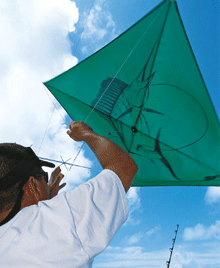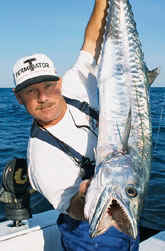Where McMullan fishes off North Carolina, he's concentrating more on small, specific fishing spots, rather than trying to cover a broad area. He anchors ahead of the spot he plans on fishing, sends out a couple live baits on floats and uses a lot of chum. While he readily uses live menhaden for flat-line baits, McMullan avoids assigning them to the kite, simply because they're not durable enough to kick up a racket for long.
For the kite, McMullan prefers a live bluefish or blue runner. His terminal rig consists of three feet of No. 5 wire, a No. 1 treble hook and a No. 2 treble for the stinger.
Before rigging up, McMullan passes his main line through a ceramic ring. The ring is then attached to the release clip on the kite. By running the line through the ceramic ring, rather than directly through the kite release clip, McMullan keeps the line from binding in the clip. The ceramic ring also provides a smoother working surface for the line to slide over.
McMullan fishes his kite bait beyond his flat lines, where it's out of the way. Sometimes he'll add a split shot to a corner of the kite, to "steer" the kite off to the side of his slick. He says the kite bait can catch big kings, and he loves watching a kingfish skyrocket a live bait.
Kite Coverage
Fishing kites present irresistible live baits to kingfish.
 |
King mackerel tournaments bring out the competitive and resourceful nature of anglers, so I am always amazed by how few of their participants use fishing kites. When I run into pros known for catching big kings, I frequently ask them why that is.
The answers range from "It's impossible to fly a kite with a lot of boats in a small area" to "The slack in the fishing line makes it hard to set the hook in a kingfish after the line falls from the kite clip on the strike." But I think these are just excuses.
Fishing kites are a regular part of my arsenal when I fish live bait off South Florida. Granted, I use kites mainly for sailfish, but they have produced large kings for me over the years, including the biggest one taken aboard my boat. That 66 3/4-pound monster, caught in the late 1980s by Margot Vincent, ate a goggle-eye dangling under a kite. That king was within a pound of beating the women's line-class world record for king mackerel on 30-pound line.
A fishing kite offers advantages that king mackerel anglers look for. For one thing, a kite helps present a bait right on the surface. Other techniques, such as slow-trolling, free-lining or drifting all present live baits swimming from just beneath the surface to several feet down. A bait fished from a kite remains at the surface, splashes up a storm and swims frantically in a large circle, all attractive to kings.
The kite also keeps hooks and leaders out of the water, free from detection. Competitive king mackerel anglers try to make low-visibility terminal rigs to fool more and bigger fish. With a fishing kite, there are no worries about having to use a wire leader that is too light, which a big king may bite through, or a hook that is too small and could pull out or straighten. The kite allows the angler to rig for the size of fish he hopes to catch.
 |
| Live bait is the best way to get the interest of a big kingfish. |
When someone says they can't fly a kite with a dozen or so boats around, consider a hot sailfish bite off South Florida. When the sails turn on, at least a couple dozen boats will fish in relatively tight quarters to capitalize on groups of sailfish pushing through a zone.
Above the Fray<
For the most part, these anglers have grown accustomed to slow-trolling or drifting with kites in a crowd. I won't deny that there are tense moments or mistakes when the fleet is packed tightly. But almost everyone is aware of and respectful of those kites and govern their slow-trolling or drift patterns accordingly. We've been flying kites in crowds in Florida for a long time.
I think that if more king anglers try the kite, others will become aware of the technique and give it a try. With more boats flying kites, crews in the fleet will quickly develop a better understanding of how to give their fellow anglers a little more fishing space.
Anchor Man
Captain Brant McMullan, owner of Ocean Isle Fishing Center in Ocean Isle Beach, North Carolina, is a noted live-bait kingfish specialist who has been experimenting with fishing kites. McMullan learned to kite-fish on sailfish, but he feels the kite works best on kingfish at anchor and chumming, versus slow-trolling or drifting.
Blue runners are good kite baits '’’ they're tough and long lasting.
 |
Off South Florida and the Bahamas, I use the kite when I drift over the reefs. For king mackerel specifically, I use three feet of No. 6 wire leader and two 4/0 or 5/0 short-shank, live-bait hooks. I place the lead hook in front of the dorsal fin of a goggle-eye, blue runner or yellowtail or through the nostrils of a speedo or tinker mackerel. I position the stinger hook near the rear dorsal fin.
When kingfish are the target, the kite rig must be tweaked. When used with sailfish, I adjust the tension on the release clip so it is just firm enough to hold a frisky bait, yet light enough to fall free easily on a strike. But with kings, I prefer more resistance and adjust the release clip so nothing short of a hard tug will pull the line free. I want the king to hook itself the moment it meets resistance from the kite bait. By the time the king tugs the fishing line free from the clip, the hook will be set. This should help to compensate for the slack that occurs from the time the fishing line falls from the clip until you come tight to the fish.
Should I miss hooking the king and still have part of my bait left, I immediately go into free spool. If the king didn't feel any resistance or sting from the hooks, it may come back and eat the remains of the bait. If it doesn't pick up the bait, I'll jig it a couple times, then let it float back. As soon as I feel the king pick up the bait, I engage the drag, wind tight to the fish and set the hook.
A fishing kite is perfect for slow-trolling or drifting live bait over hard bottom or around an oil rig in the Gulf of Mexico. It also works with bait pods along the beach, along channel edges and buoy lines and even tide rips, where fish feed.
If you want to try kite-fishing for kingfish, keep it simple. There's no need to get fancy and fly two kites with four baits on each, like a sailfish pro. Start with one bait and concentrate on getting the presentation right. When you're comfortable, add a second bait.
A simple kite setup requires a conventional reel that can hold a few hundred yards of 50- or 80-pound-test Dacron or monofilament and a short, stout rod. Strip off 60 to 90 feet of line from the reel, cut the line and reattach the two sections with a barrel swivel that's large enough to stop the kite release clip. Reel in the line, slide on a release clip and tie on a ball-bearing snap swivel. Pick a light-, medium- or heavy-wind kite, attach it to the swivel and you're all set.
If you get confident and want to fish multiple baits off one kite, add another barrel swivel 50 or 60 feet behind the first one and another swivel some 50 or 60 feet behind that one. Use snap-on-style release clips on these swivels.
Big kingfish are suckers for live baits dangled beneath a fishing kite, so give one a try. With a little practice and luck, you too may put one over on a trophy kingfish.

